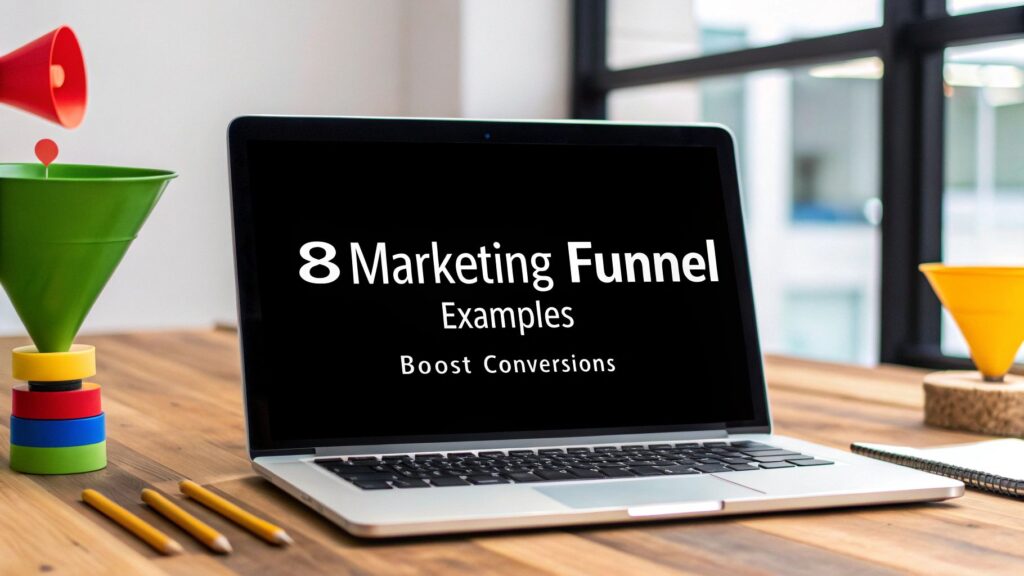
Marketing Funnels 101: A Strategic Guide
Creating success in business requires more than just an excellent product. The key is understanding how to guide potential customers through their buying journey using marketing funnels – the strategic path from initial awareness to final purchase.
Marketing funnels have evolved significantly since the classic AIDA model (Attention, Interest, Desire, Action). Modern digital funnels help businesses understand exactly how customers move from first discovering a product to making a purchase decision. The most effective funnels combine deep customer knowledge, carefully chosen engagement points, and targeted messaging that resonates at each stage.
Looking to build your own high-converting marketing funnel? This guide examines 8 real-world examples of marketing funnels that delivered impressive results across different industries. For each example, we'll analyze what worked well, potential areas for improvement, and practical tips you can apply to your own business.
Whether you're starting your first business venture, working in marketing, growing a podcast audience, building an agency, or exploring entrepreneurship – you'll find actionable insights to help craft marketing funnels that align with your specific goals and target audience. Let's explore how to create customer journeys that consistently drive growth and conversions.
1. AIDA Funnel
The AIDA model stands for Attention, Interest, Desire, and Action – four key stages that describe how customers move toward making a purchase. This straightforward framework has proven essential for marketers, salespeople and business owners who want to understand and guide their customers' buying journey.
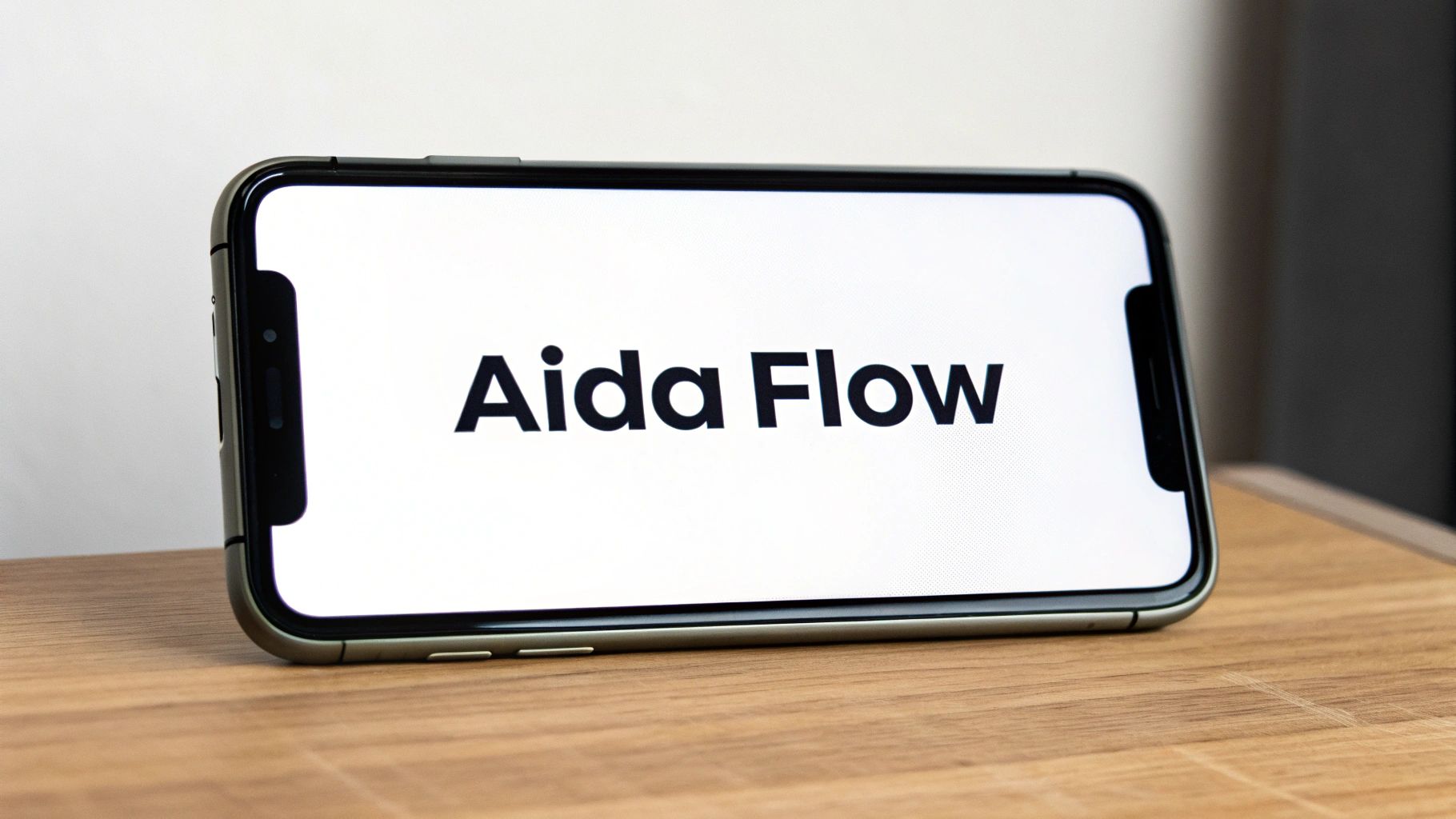
Four Stages of the AIDA Funnel:
- Attention: Capture potential customers' notice through eye-catching ads, social posts, headlines or visuals
- Interest: Build engagement by sharing relevant content about your product's benefits and unique features
- Desire: Show why customers need your offering through social proof, testimonials and clear value propositions
- Action: Guide prospects to take the next step with clear calls-to-action for purchases, sign-ups or other goals
Features & Benefits:
The AIDA model gives marketers a clear roadmap for connecting with customers at each stage. Its focus on both rational and emotional factors helps create messaging that resonates. The model's flexibility makes it valuable across many industries, from B2B software to consumer products.
Pros:
- Easy to understand and apply
- Proven record of driving sales over many years
- Works well for both B2B and B2C
- Clear objectives for each stage
Cons:
- May oversimplify complex buying journeys
- Doesn't address customer retention
- Can be too rigid for modern buying behaviors
Examples:
-
Apple Product Launches: Grabs attention with pre-launch buzz and presentations. Creates interest through innovative features. Builds desire with lifestyle benefits. Drives action through pre-orders.
-
Nike Marketing: Captures attention with powerful visuals. Generates interest through athletic achievement stories. Creates desire with athlete endorsements. Prompts action through targeted campaigns.
-
Amazon Product Pages: Gets attention with clear images. Builds interest through detailed specs and reviews. Creates desire with competitive pricing. Enables action through one-click buying.
Tips for Implementation:
- Attention: Use compelling headlines and striking visuals
- Interest: Share engaging stories and key benefits
- Desire: Showcase customer testimonials and reviews
- Action: Include clear, specific calls-to-action
Historical Context:
While earlier versions existed, E. St. Elmo Lewis is credited with formalizing the AIDA model in the late 1800s to improve sales processes. Marketing experts later refined it into the practical framework still used widely today.
2. ToFu-MoFu-BoFu Content Funnel
This proven marketing approach helps businesses create targeted content for each stage of the buyer's journey. By breaking down the sales funnel into Top of Funnel (ToFu), Middle of Funnel (MoFu), and Bottom of Funnel (BoFu), companies can engage leads effectively and guide them to conversion.
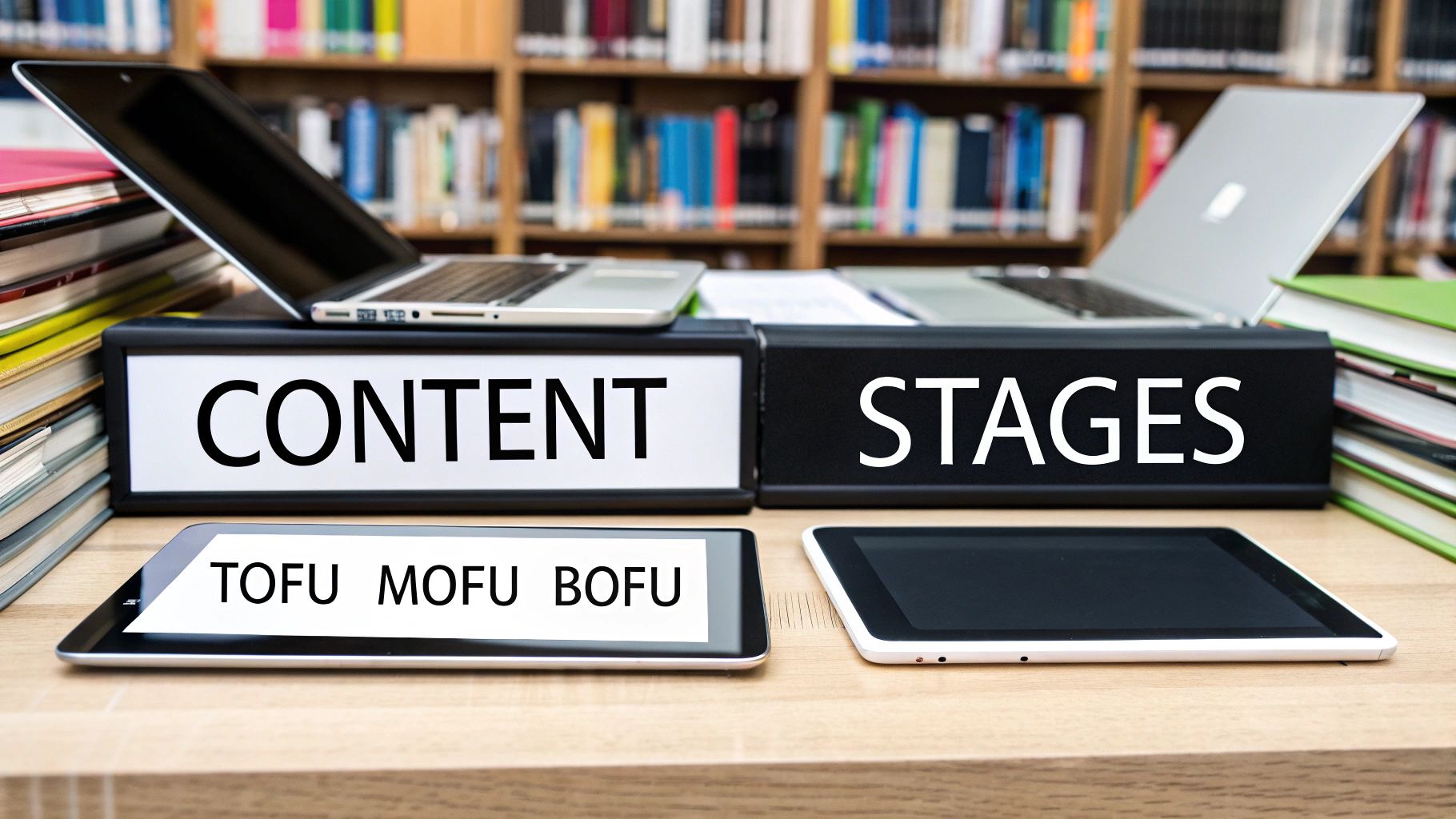
How it Works:
The funnel reflects how customers move from initial discovery to final purchase:
-
ToFu (Awareness): New visitors are learning about their needs. Content focuses on education and building trust through blog posts, infographics, and social media that answer common questions.
-
MoFu (Consideration): Prospects understand their problem and explore solutions. Content dives into specific benefits through case studies, webinars, and ebooks targeting pain points.
-
BoFu (Decision): Ready-to-buy leads need final convincing. Content emphasizes product features through demos, trials, testimonials, and pricing details.
Key Benefits:
The model offers clear advantages for content marketing:
- Organized framework for planning content at each stage
- Natural progression from educational to promotional content
- Targeted messaging aligned with buyer needs
- Multi-channel reach across different platforms
Pros:
- Focused content strategy for each stage of the buying process
- Works for any size business or industry
- Clear performance tracking through analytics
- Better lead nurturing for higher conversion rates
Cons:
- Time-consuming content creation process
- Ongoing effort needed to maintain fresh content
- Long-term investment before seeing major results
Real-world Examples:
- HubSpot: Their blogs, guides and webinars effectively guide leads through each funnel stage.
- Moz: Offers SEO resources from beginner content to advanced tools.
- Salesforce: Resource center includes materials for every stage of the CRM buying journey.
Implementation Tips:
- ToFu: Create educational content answering common industry questions
- MoFu: Develop detailed resources showing your solution's value
- BoFu: Focus on conversion content like trials and comparisons
- Track results: Monitor key metrics to improve your strategy
Background:
First championed by HubSpot and Content Marketing Institute, this approach has become essential for modern marketing. Its focus on the buyer's journey makes it highly effective for lead generation and sales.
You might be interested in: Omnichannel Content Strategy and Why It's a Must. Using multiple channels helps ensure your ToFu-MoFu-BoFu content reaches potential customers wherever they are. This model earns its place through proven results and wide adoption across industries, giving marketers a practical way to connect with buyers at every stage.
3. Value-First Funnel
The Value-First Funnel takes a new approach to customer acquisition. Instead of pushing for immediate sales, it focuses on providing substantial value through free resources and content before asking for any commitment. This approach naturally builds trust and establishes credibility, leading to better conversion rates and more loyal customers.
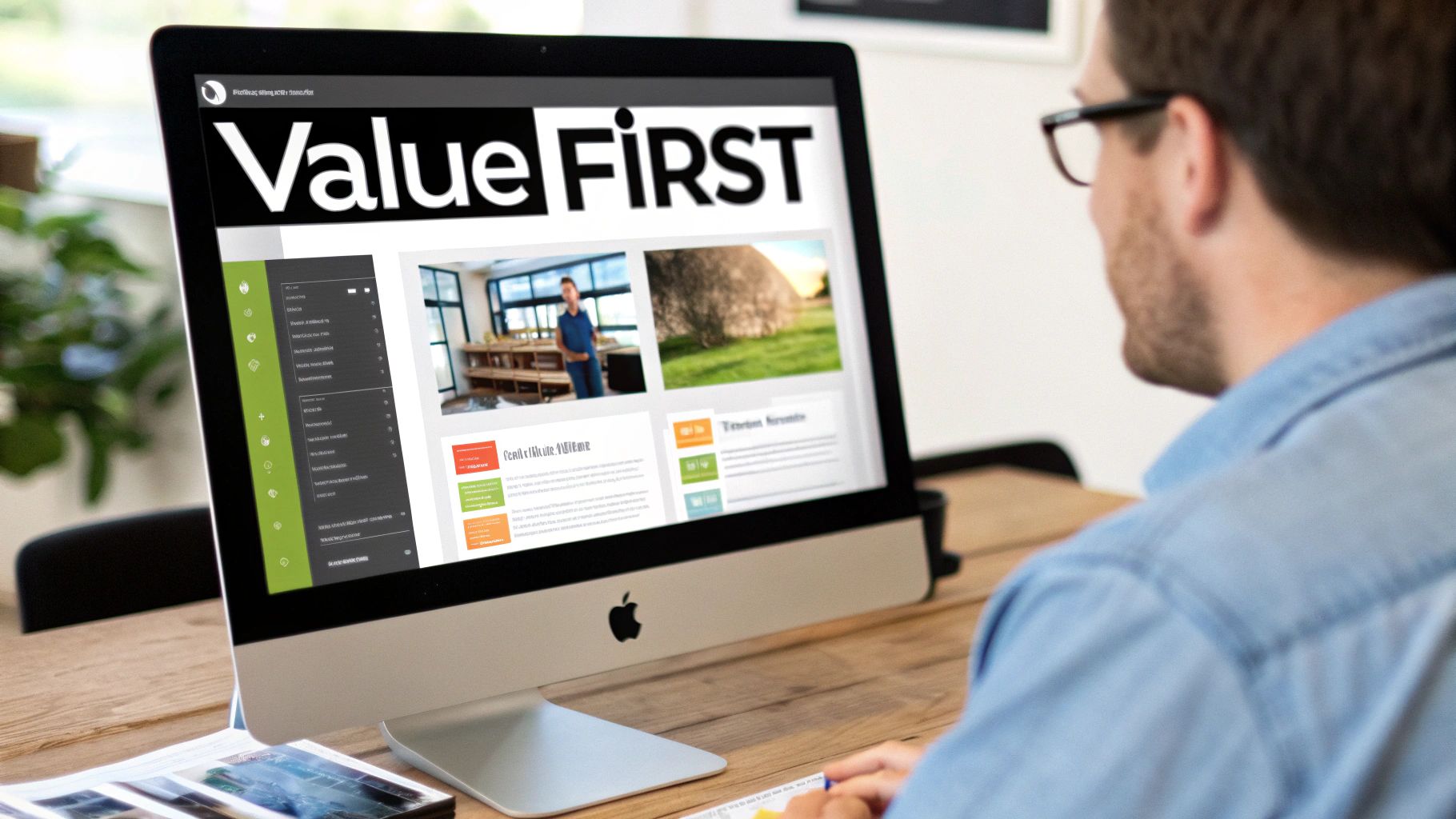
How it Works
The concept is straightforward – give value before asking for anything in return. This funnel prioritizes educational content, useful tools, and community building to attract potential customers. Free resources serve as lead magnets to capture contact information, allowing for relationship nurturing over time. Sales naturally follow once trust and demonstrated value are established.
Key Features
- High-Value Free Content: Includes helpful blog posts, downloadable guides, software trials, and practical tools
- Educational Focus: Emphasis on solving real problems and sharing knowledge to position your brand as a trusted resource
- Community Elements: Building connections through discussion forums, social groups, and interactive events
- Strategic Monetization: Focusing first on growing an engaged audience, with sales emerging naturally from established relationships
Pros
- Creates Brand Champions: Customers who receive genuine help often become loyal advocates
- Better Sales Results: Built trust leads to more confident purchasing decisions
- Cost-Effective: Word-of-mouth marketing reduces paid advertising needs
- Natural Growth: Satisfied customers eagerly share helpful resources with others
Cons
- Slower Revenue Timeline: Building trust and relationships takes patience
- Resource Investment: Creating quality free content requires dedication and budget
- Free-Only Users: Some may never convert beyond consuming free materials
Real-World Examples
- Ahrefs: Offers free SEO tools and in-depth content to showcase their premium software
- Ubersuggest: Provides free SEO tools that drive interest in paid consulting
- Buffer: Shares social media insights and free plan to demonstrate premium features
Implementation Tips
- Focus on Quality: Ensure free resources deliver real, practical value
- Create Depth: Develop thorough educational materials that show your expertise
- Build Your List: Use valuable content to grow email subscribers for ongoing nurture
- Stay Consistent: Regular delivery of helpful content maintains engagement
Growing Popularity
This funnel strategy has gained traction as more businesses recognize the power of content marketing and relationship building. It works especially well for reaching entrepreneurs, marketers, and business owners actively seeking growth resources. The approach reflects a shift toward genuine value exchange over aggressive selling.
You might be interested in: Value Proposition Examples. Understanding your core value offering helps create free resources that truly connect with your audience. This funnel deserves attention because it offers a sustainable way to build lasting customer relationships through genuine help and authentic connection.
4. Webinar Funnel
Webinars have emerged as an effective marketing tool that combines education with direct selling opportunities. They work especially well for selling high-ticket items, coaching programs, and online courses where buyers need a deep understanding of the value before purchasing.
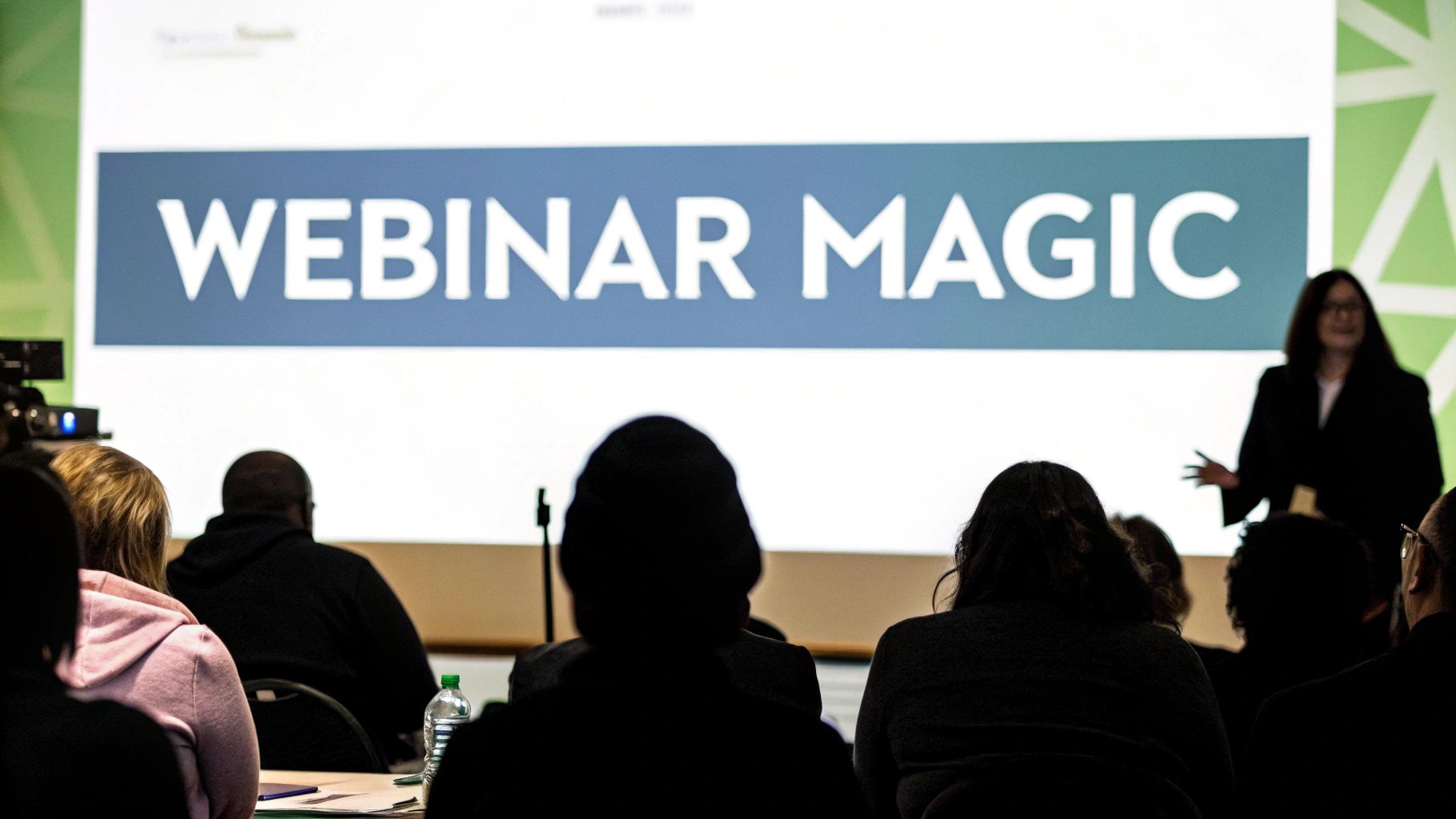
A typical webinar funnel includes a live or automated presentation, email signup process, follow-up sequence, and a mix of teaching and selling. The presenter delivers useful content about their audience's challenges while naturally positioning their product or service as the solution.
Pros:
- High engagement rates: Interactive learning and Q&A sessions create much stronger engagement compared to other content types
- Builds trust quickly: Sharing valuable expertise helps establish credibility and connection with viewers
- Great for premium offerings: Extended format allows for thorough explanation of complex products/services
- Can be automated: Pre-recorded webinars let you reach more people without live presentations each time
Cons:
- Technical issues possible: Running webinars requires comfort with technology and platforms
- Takes work to create: Quality webinar content needs significant planning and preparation
- Speaking skills required: Keeping an audience engaged for an hour demands strong presentation abilities
Examples:
ClickFunnels created the widely-used "Perfect Webinar" script. Tony Robbins promotes his coaching through webinar-style events. Digital Marketer teaches marketing strategies via online workshops.
Tips for Success:
- Focus on practical value: Give attendees tips and strategies they can use right away
- Share real examples: Include case studies that prove your approach works
- Add time-sensitive offers: Special webinar-only deals create urgency
- Follow up consistently: Use email and ads to nurture leads after the event
Marketing experts like Russell Brunson and Frank Kern helped popularize webinar funnels by showing their revenue potential. This format works well with modern audiences who appreciate in-depth online learning. For entrepreneurs, marketers, freelancers, and agency owners, webinars offer a proven way to build authority and drive sales.
Want to explore more ways to attract clients? Read: Proven Client Acquisition Strategies To Drive Business Growth
5. Product Launch Formula (PLF)
The Product Launch Formula is a proven method for launching new products by creating anticipation and demand before release. Created by Jeff Walker, this approach focuses on building interest through strategic content releases before the actual product launch.
How PLF Works:
The heart of PLF is releasing valuable pre-launch content through email, video, or webinars. Instead of immediately selling, you share helpful free content that addresses your audience's needs. This builds trust and positions your upcoming product as the natural solution. As launch day gets closer, you gradually introduce product details and benefits, leading to a time-limited offer.
Key Features:
- Pre-launch Content: Free valuable content (videos, webinars, guides) delivered before launch
- Educational Approach: Teaching and helping rather than direct selling
- Social Proof: Using testimonials and case studies to build credibility
- Limited-Time Offers: Creating urgency with special bonuses and deadlines
Pros:
- Strong Launch Results: Pre-launch excitement leads to high sales on launch day
- Better Conversion: Warmed-up audience more likely to buy
- Built-in Excitement: Gradual reveals create natural anticipation
- Clear Framework: Step-by-step system you can use repeatedly
Cons:
- Takes Work: Requires careful planning and content creation
- Time Investment: Quality pre-launch materials need significant preparation
- Risk of Overuse: Can seem insincere if not done authentically
Real-World Examples:
- iPhone Launches: Apple builds massive buzz with pre-launch events and strategic information releases
- Online Courses: Course creators use PLF to drive enrollment through preview content
- Software Releases: Tech companies roll out features gradually to build interest
Implementation Tips:
- Focus on Value: Create genuinely helpful pre-launch content
- Get Early Feedback: Collect testimonials from beta users
- Build Your List: Grow your email audience before launching
- Be Genuine: Only use real scarcity, avoid fake deadlines
Growth and Impact:
Jeff Walker's book "Launch" introduced PLF to a wider audience. Since then, countless entrepreneurs have adapted these principles for their own successful product launches.
Why PLF Works:
The Product Launch Formula succeeds because it focuses on building relationships and trust before asking for the sale. By providing value upfront and creating natural anticipation, PLF helps products launch stronger and convert better than traditional approaches.
"Quiz Funnel" with a clear, human style:
6. Quiz Funnel
The Quiz Funnel is a powerful marketing tool that connects with prospects through interactive quizzes that help understand their needs and guide them to relevant solutions. Unlike passive sales methods, this approach makes lead generation feel more like a conversation, which naturally appeals to potential customers. It's proven to be highly successful at generating quality leads and building stronger relationships.
How it Works:
The process starts with an engaging quiz related to your field. Users move through personalized questions and get customized recommendations based on their answers. This individual attention helps users feel heard and understood, making them more likely to take the next step.
Features:
- Interactive Quiz Element: The quiz should be both fun and informative while staying relevant to what your audience cares about
- Personalized Results: The quiz outcome needs to offer real value with specific solutions matched to user responses
- Lead Capture Integration: Smoothly collect email addresses within the quiz experience for future marketing
- Custom Follow-up Sequences: Use quiz answers to segment your audience and send targeted emails with relevant content and offers
Pros:
- High Engagement Rates: People naturally engage more with interactive content compared to static pages
- Valuable Data Collection: Learn directly about customer preferences and pain points to improve your marketing
- Personalized Experience: Custom results help build genuine connections with potential customers
- Viral Potential: Well-made quizzes can spread rapidly through social sharing, like BuzzFeed's popular formats
Cons:
- Development Costs: Building a good interactive quiz requires investment in tools or development
- Maintenance Required: Regular updates needed to keep content fresh and working properly
- May Not Suit All Industries: Some business types may find quiz formats less effective
Examples:
- BuzzFeed Quizzes: The company that made quiz content a social phenomenon
- Zenni Optical's Style Quiz: Helps shoppers find eyeglass frames that match their style
- Warby Parker's Quiz: Guides customers to eyewear options that suit them best
Tips for Implementation:
- Keep Questions Engaging: Mix different question types including images and multiple choice
- Provide Valuable Results: Give actionable insights and helpful recommendations
- Integrate Email Capture Naturally: Offer clear value in exchange for contact information
- Use Data for Personalization: Apply quiz responses to create more targeted marketing
Popularized By:
Ryan Levesque pioneered the "Ask" method and Lead Quizzes platform, helping establish quiz funnels as a core marketing strategy. His work showed how interactive content could transform standard marketing into something more engaging and effective.
The Quiz Funnel offers a fresh take on connecting with customers. By focusing on interaction and personalization, businesses can build deeper audience connections while gathering insights that drive conversions.
7. Challenge Funnel
The Challenge Funnel is a proven marketing approach that connects with audiences through time-bound challenges lasting 5-30 days. By providing quick wins and building community engagement, it helps businesses create loyal audiences while showcasing their value.
How it Works:
Each challenge provides daily tasks or content over a set timeframe. Participants commit to completing these activities, which builds momentum and accountability. The challenge concludes with a defined outcome that rewards completion. A key component is the community aspect – usually through online groups where participants support each other and interact with challenge leaders.
Features:
- Set Duration: A clear timeframe creates urgency and commitment
- Daily Activities: Bite-sized tasks maintain consistent engagement
- Community Space: Shared forums enable connection and accountability
- Clear End Goal: A defined outcome keeps participants motivated
Pros:
- Strong Engagement: The structure and community drive active participation
- Community Building: Participants naturally connect over shared goals
- Quick Results: Short timeframe shows value rapidly
- Natural Sales Path: Success primes participants for premium offerings
Cons:
- Resource Heavy: Creating and running challenges takes significant effort
- Ongoing Support: Active community management is essential
- Participant Drop-off: Strategies needed to maintain motivation
Examples:
- 75 Hard Challenge: Andy Frisella's mental toughness program requires two daily workouts, strict diet, and other tasks for 75 days
- 30 Day Fitness Programs: Help participants achieve specific fitness goals
- Writing Challenges: Build daily writing habits and complete projects
Community Growth:
Social media has powered the growth of challenge marketing. Fitness influencers and entrepreneurs like Andy Frisella have shown how challenges can build engaged online communities at scale.
Tips for Success:
- Keep Daily Tasks Doable: Balance challenge with achievability
- Build in Accountability: Use check-ins and progress tracking
- Foster Community: Regular prompts, Q&As, and celebrations
- Plan Next Steps: Clear path to main offerings post-challenge
With strategic planning, strong community support, and valuable content, Challenge Funnels can help you build an engaged audience while effectively demonstrating your value proposition.
8. Tripwire Funnel
A Tripwire Funnel, sometimes called a low-barrier offer funnel, helps turn potential customers into paying ones by offering an attractive, budget-friendly first purchase. The initial "tripwire" product leads customers to progressively higher-value offers through a carefully planned series of upgrades and related products.
How It Works:
The key to the Tripwire Funnel is getting customers to make small commitments. Starting with a very affordable first purchase (even just $1) makes it easier for people to say yes. Once they've made that initial buy, they're more likely to consider additional, pricier offerings. The funnel then presents relevant upgrades right after the first purchase.
Features:
- Budget-Friendly Entry: The first offer is very affordable, making it easy for new customers to try your product
- Quick Upsell Flow: Additional offers appear right after the first purchase
- Step-by-Step Value: Each upsell provides more benefits and addresses bigger customer needs
- Fast Delivery: Products reach customers quickly to keep momentum going
Pros:
- Easy First Step: Low initial price helps convert more prospects into customers
- Better Long-Term Value: Customers tend to spend more over time through multiple purchases
- Simple to Refine: You can test different offers to find what works best
- Fast Results: Low acquisition costs plus quick upsells can generate profits quickly
Cons:
- Deal-Seeking Buyers: The low entry price might attract customers who only want bargains
- Needs Strong Follow-Up: Success depends on having appealing upgrade offers
- Risk of Pushiness: Customers may feel pressured if upsells seem aggressive
Examples:
- Amazon Kindle: Offers discount books to attract readers before suggesting full-price titles
- Information Products: Many sellers use low-cost reports to lead into courses or coaching
- Dollar Shave Club: Starts with an affordable starter kit before offering premium razors and grooming items
Tips for Success:
- Deliver Real Value: Even low-cost items must provide clear benefits
- Connect Your Offers: Each upsell should naturally build on previous purchases
- Test Different Prices: Find the sweet spot for both initial and upgrade offers
- Put Customers First: Focus on positive experiences to build lasting relationships
Key Influencers:
Marketing experts Perry Marshall and Ryan Deiss have helped develop and promote Tripwire Funnel strategies across many industries, showing how it can effectively attract and retain customers.
Why It Makes The List:
The Tripwire Funnel earns its spot because it excels at converting prospects and building customer value. Its proven approach to sales and upgrades helps businesses grow steadily, making it essential for entrepreneurs and marketers looking to build successful online ventures.
8 Marketing Funnel Strategies Comparison Guide
| Strategy | 🔄 Complexity | ⚡ Resources | 📊 Outcomes | 💡 Use Cases | ⭐ Advantages |
|---|---|---|---|---|---|
| AIDA Funnel | Low – straightforward linear progression | Minimal – focus on clear messaging | Steady conversion guidance | B2B/B2C product marketing | Proven, easy to understand, clear stage objectives |
| ToFu-MoFu-BoFu Content Funnel | Moderate – multi-stage content mapping | High – requires consistent content creation | Nurtured leads with measurable progress | Content marketing across industries | Highly targeted, scalable, strong lead nurturing |
| Value-First Funnel | Moderate – demands upfront value creation | High – significant investment in free resources | Builds strong trust and long-term loyalty | Authority building in digital marketing | Higher conversions and strong brand loyalty |
| Webinar Funnel | Moderate – combines technical and presentation skill | Moderate to high – requires planning and robust tech setup | High engagement with immediate trust building | High-ticket sales and educational events | Scalable, engaging, and effective for rapid relationship building |
| Product Launch Formula (PLF) | High – intricate pre-launch sequencing | High – extensive planning and preparatory content | Creates strong launch momentum with high conversion rates | New product, course, or software launches | Replicable system with strong anticipation and conversion focus |
| Quiz Funnel | Moderate – interactive design integration required | Moderate – investment in development and data management | Personalized engagement and improved lead capture | Interactive and viral marketing campaigns | High engagement, valuable insights, and effective data collection |
| Challenge Funnel | Moderate – fixed duration with structured tasks | High – ongoing support and community management required | Rapid engagement and effective community building | Fitness, writing, or skill challenges | Quick value demonstration and natural upsell opportunities |
| Tripwire Funnel | Low to moderate – simple low-cost offer setup | Low – minimal entry cost with strategic upsell planning | Quick conversion and fast ROI potential | E-commerce and digital product offerings | Low barrier to entry and increased customer lifetime value |
Choosing the Right Funnel for Your Success
We've examined several powerful marketing funnels – from the classic AIDA model to modern Challenge Funnels. Each approach, whether the ToFu-MoFu-BoFu content strategy or interactive Quiz Funnels, has specific benefits for guiding prospects through their buying journey. The key insight is that you need to select a funnel that fits your unique situation. The Product Launch Formula works well for new offerings, while a Value-First Funnel excels at relationship building. Small details matter too – like using tripwire offers strategically within your sales process.
Success requires thoughtful planning and execution. Start by creating your ideal customer profile and mapping their decision process. Ask yourself: Which touchpoints drive the most engagement? Where do people drop off? What content resonates best? These insights help you build a funnel that effectively nurtures leads. For example, if your audience loves interactive content, Quiz or Challenge Funnels might be perfect. But if your product needs detailed explanation, Webinar Funnels could work better.
Keep testing and improving your funnel over time. Track important metrics like conversion rates, bounce rates, and customer lifetime value. Run A/B tests to see what works best with your audience. Marketing channels and customer preferences change frequently, so stay informed about developments in personalization, automation, and interactive content. This helps you keep your funnels performing well.
Key Takeaways:
- No one-size-fits-all: Choose the funnel that aligns with your business, audience, and resources.
- Customer-centricity: Understand your customer journey and tailor your funnel accordingly.
- Data-driven optimization: Track, analyze, and adapt based on performance data.
- Continuous learning: Stay updated on trends and future developments to maintain a competitive edge.
Want to master building effective marketing funnels? Jason Yormark, agency owner, author, podcaster, and public speaker, offers valuable insights for entrepreneurs and marketers. Through his "Anti Agency" initiative focusing on work freedom, engaging podcast, and informative blog, Jason shares expert knowledge on marketing, social media, and business growth. Visit Jason Yormark to access strategies for entrepreneurial success.


Leave a Reply